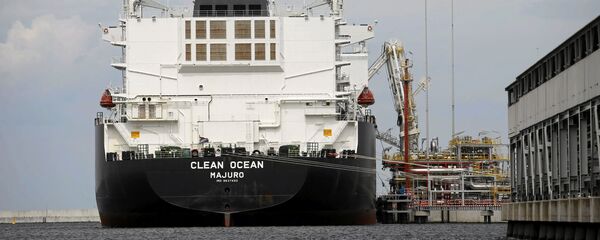Polish state-run gas company PGNiG announced on October 17 that it had finalized a 20-year deal with the US-based Venture Global LNG producer to import up to 2 million tons of LNG — or 2.7 billion cubic meters after re-gasification — annually.
However, although PGNiG's CEO Piotr Wozniak claims that US LNG will cost about 20-25 percent less than the Russian pipeline gas for Poland, the much celebrated deal appears to be fraught with risks.
Under the contract, the Polish company is obligated to buy US LNG from two of Venture Global's subsidiaries on a free on board (FOB) from 2022, when the Venture Global Calcasieu Pass LNG export facility is expected to become operational. The agreement struck by the former government of Waldemar Pawlak with Moscow on the supplies of Russian natural gas will expire the same year.
On the other hand, according to Wozniak, Poland will be able to re-sell the acquired LNG worldwide. It is probable that while striking the deal, Polish exporters had China's rapidly growing energy market in mind. Indeed, it is expected that the People's Republic of China's gas demand will grow by 60 percent between 2017 and 2023, reaching 376 billion cubic meters (bcm).
One can't rule out that Warsaw wants to capitalize on the US-China energy spat that erupted after Donald Trump announced a third round of tariffs against Beijing. The People's Republic has dramatically decreased purchases of US LNG and oil and eventually stopped them. Under these circumstances, Poland may play the role of an intermediary between the two rivals.
And as frosting on the cake, the Polish state-owned company can possibly use the contract with Venture Global as a lever to exert pressure on Gazprom post-2022.
However, as of yet, the details of the contract have not been revealed, prompting justified suspicions about Warsaw's benefits.
Given this, it seems unlikely that the deliveries of American super-chilled fuel will be cheaper than the Russian pipeline hydrocarbons.
Second, Calcasieu Pass and Plaquemines, where PGNiG is supposed to buy LNG, are scheduled to become operational in 2022 and 2023, respectively. Moreover, the US Federal Energy Regulatory Commission (FEARC) has yet to issue permission to build these plants.
Third, there are no guarantees that Poland will manage to occupy a niche on the Chinese energy market in 2022: on December 20, 2019, Gazprom's Power of Siberia will begin to pump cheap pipeline gas to the People's Republic, delivering 38 bcm of gas annually.
It is doubtful that PGNiG will manage to earn dramatically in this highly competitive environment.
As for Warsaw's apparent incentive to use American liquefied natural gas as a tool to manipulate Russia into making concessions, it also looks hollow: pipeline gas is typically less expensive than LNG.
While Poland's financial benefits from the much-discussed deal do not look very obvious, Warsaw is appearing to use LNG purchases to boost US-Polish relations. Meanwhile, however, Poland bought just 3.4 billion cubic feet (0.097 billion cubic meters) of LNG from Washington in 2017. For comparison's sake, Moscow provided the Eastern European country with 10.47 billion cubic meters of hydrocarbons in the same year.




